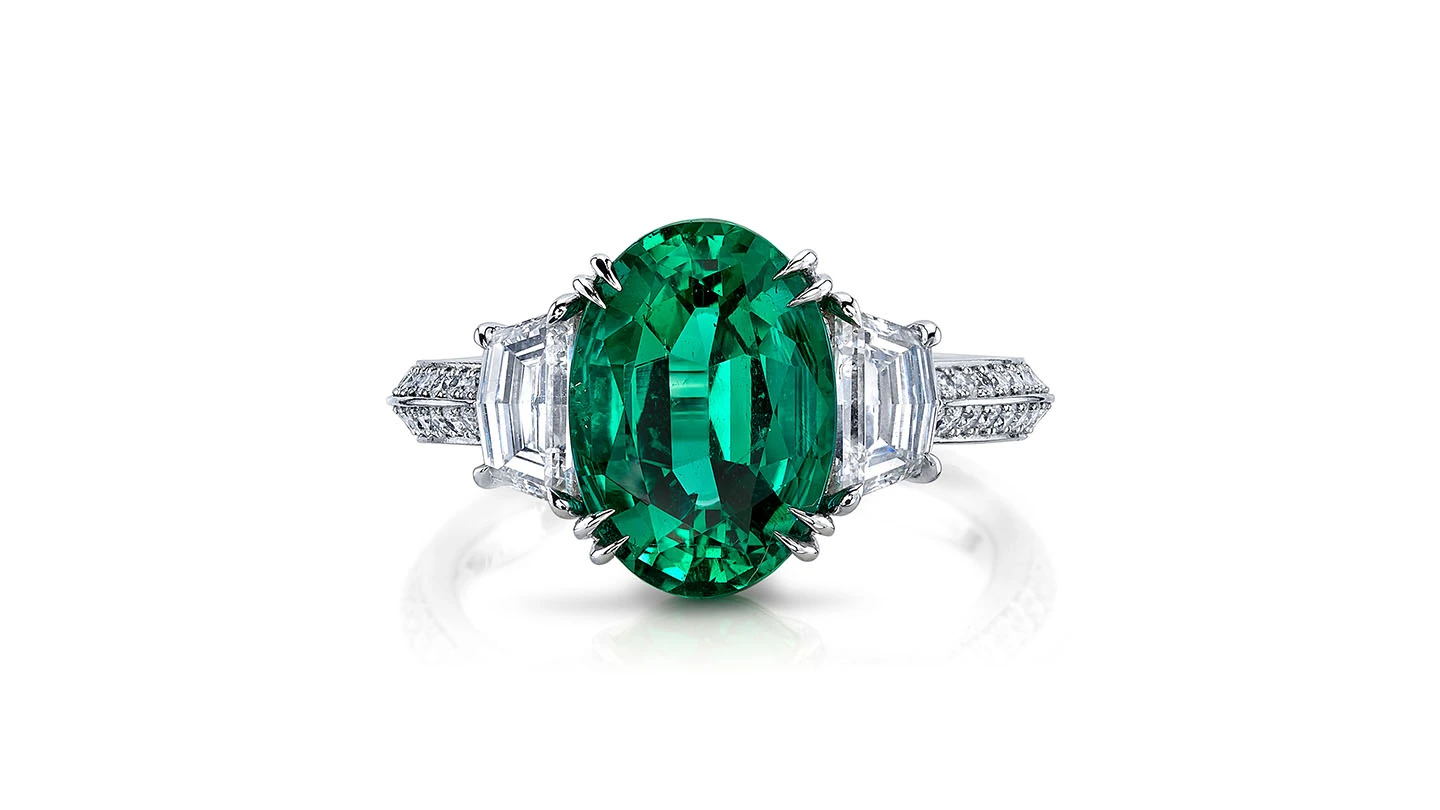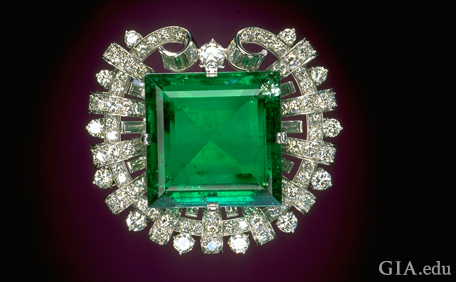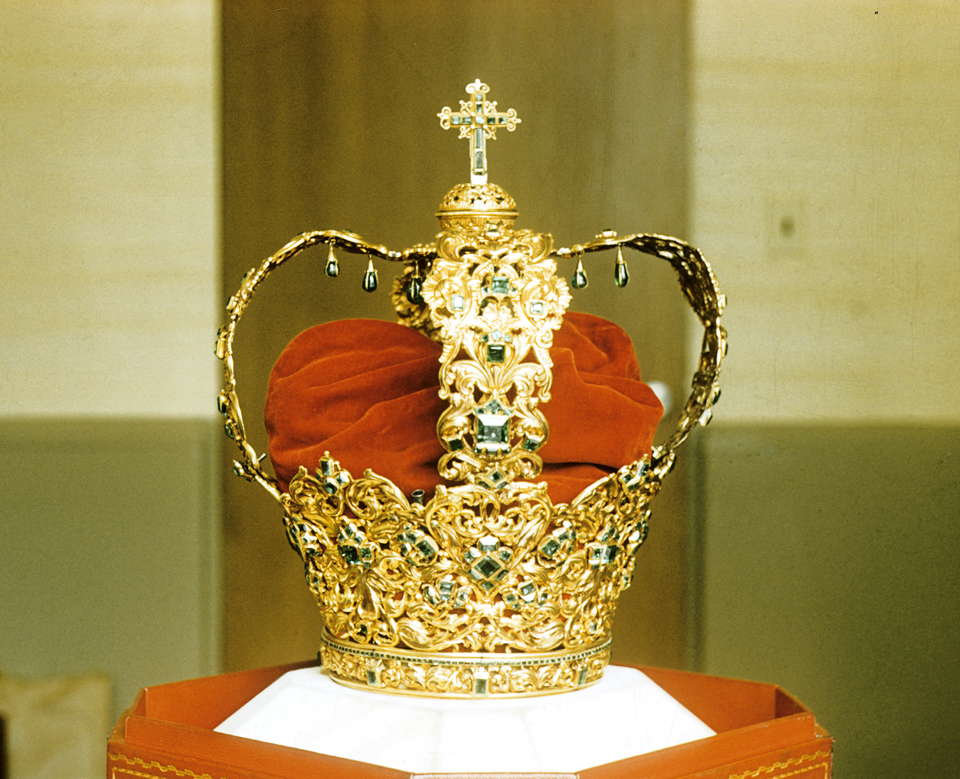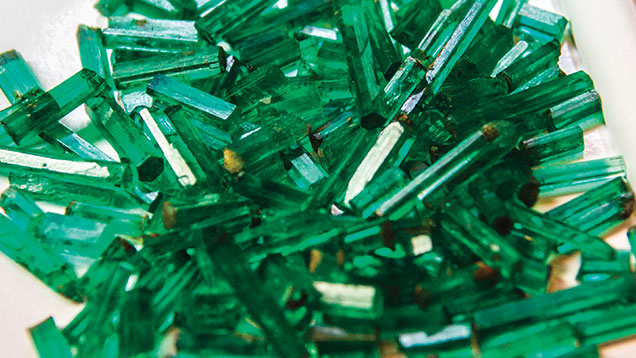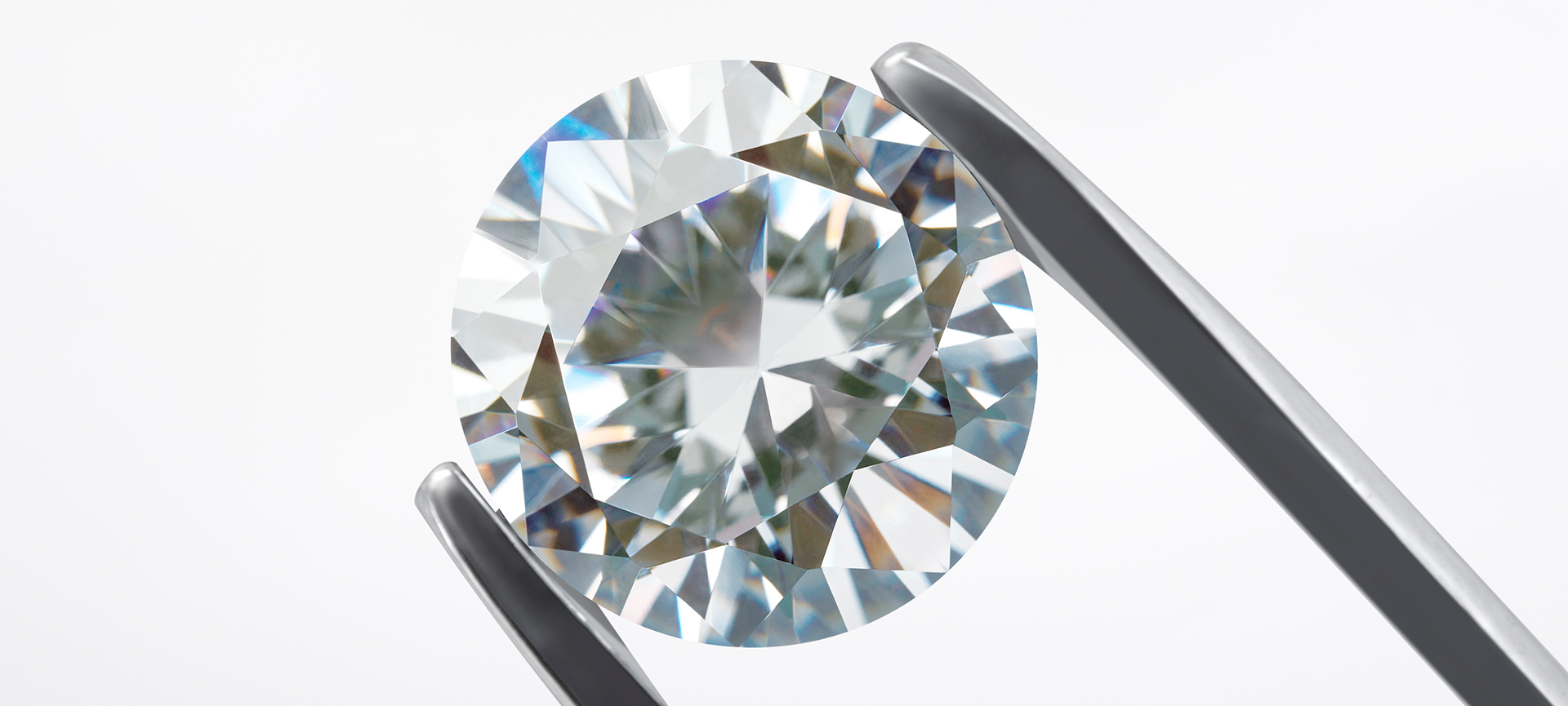With spring in full bloom and summer just around the corner, emerald is the perfect choice for the May birthstone. Kings and queens have prized the sought-after green gem for centuries. Here’s how you can pick a breathtaking one.
In this post, we cover:
Gemological Qualities of Emerald
Emerald History & Lore
Where Emerald Comes From
Emerald Qualities to Look For
Emerald Care & Cleaning
May Birthstone: Gemological Qualities of Emerald
Emerald’s green has been the standard by which other green gemstones have been measured for thousands of years. It is the rich green to bluish green variety of beryl, a mineral species that also includes aquamarine and varieties in other colors.
Trace elements that cause emerald’s color include chromium, vanadium and iron. As a general rule, the higher the chromium or vanadium content, the more intense the green color. The more iron present, the greater the degree of blue. When iron content is relatively high, emerald is a bluer green. When iron content is relatively low, the May birthstone is a purer green.
The difference between an emerald and a less-expensive green beryl is a matter of debate among gem experts. Some in the trade describe the May birthstone as any green beryl colored by chromium. However, gemologists, gemological laboratories and most colored stone dealers, think it is incorrect to call a green beryl an emerald when its color is “too light.” There are differences of opinion even in this group about the definition of “too light.” GIA settles the debate by using lab-graded comparison stones to determine if the green color is sufficiently dark and saturated to be called emerald.
Gemologists love the May birthstone for its inclusions. Emeralds from Colombia can have fascinating characteristic inclusions – called three-phase inclusions – that consist of tiny crystals of rock salt, a liquid and a bubble of gas.
The best emerald crystals are also gorgeous flat-topped green hexagonal columns that can rival the beauty of faceted stones.
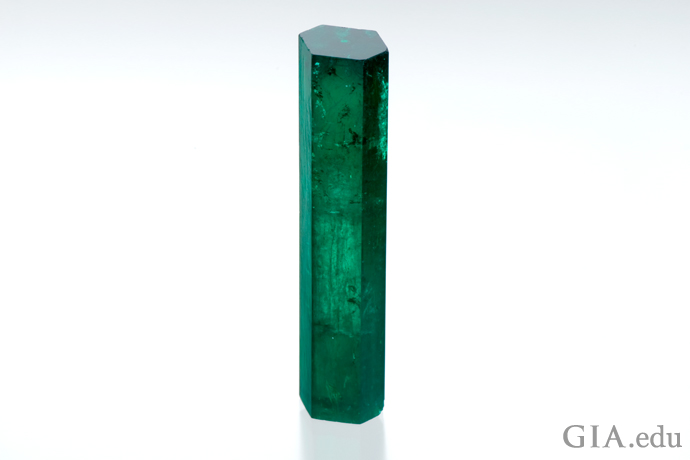
Weighing in at 47 carats, this rough emerald crystal from the Muzo mine in Colombia is so beautiful that it may put to rest all debates about color. Photo: Robert Weldon/GIA. Courtesy: Jon Sigerman
May Birthstone: Emerald History & Lore
From Egyptian pharaohs to Inca emperors, emerald has enchanted royalty. Cleopatra was known to have a passion for emerald, and used it in her royal adornments. The legendary Crown of the Andes, fashioned in colonial South America, is one example of how the Spanish revered the May birthstone. According to lore, its largest stone—now called the Atahualpa emerald—was taken from the last Inca emperor, Atahualpa, by conquistador Francisco Pizarro. The modern recovery of the Spanish galleon Nuestra Señora de Atocha shows the length generations of treasure hunters would go to recover its sunken loot.
The word “emerald” comes from smaragdos, ancient Greek for a green gem. Roman author Pliny the Elder, who died in the 79 CE eruption of Mt. Vesuvius, wrote in his encyclopedic Natural History that “nothing greens greener.” He also stated that the May birthstone had therapeutic properties that helped gem cutters: “(they) have no better method of restoring their eyes than by looking at the emerald, its soft, green color comforting and removing their weariness and lassitude.” Science now proves this belief: The color green relieves stress and eye strain.
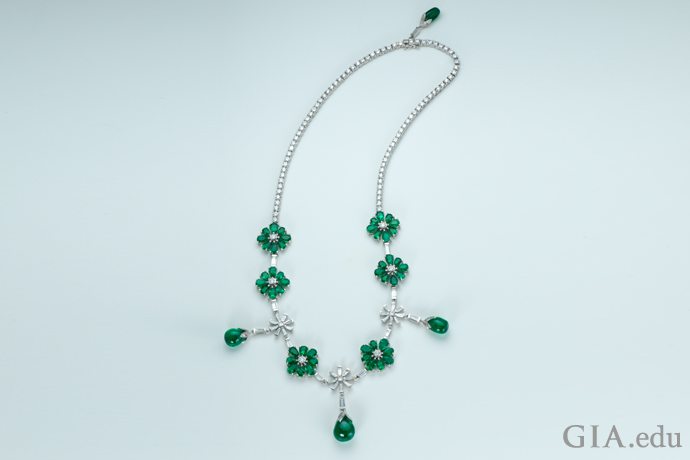
An emerald necklace sure to soothe the eye, this beauty has 52 emeralds, with a total weight of 32.86 carats, and 160 diamonds, with a total weight of 9.11 carats. Photo: Robert Weldon/GIA. Courtesy: Ismael Daoud
Emerald was also thought to have magical powers. By placing it under the tongue, one could see into the future. Some believed the May birthstone offered protection against evil spells, cholera and malaria. Others thought it made one an eloquent speaker and exposed lovers who made false promises.
Emerald is traditionally given for the 20th and 35th wedding anniversaries.
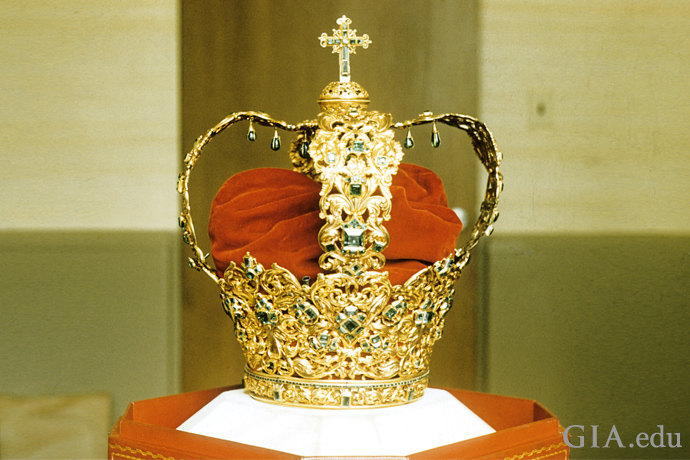
The Crown of the Andes, now at the Metropolitan Museum of Art in New York City, boasts an impressive 24 ct emerald center stone and 442 additional emeralds set in the golden headpiece. Photo: Dr. E. J. Gübelin/GIA
May Birthstone: Where Emerald Comes From
Colombia has been the source of the finest emeralds for more than 500 years, and they have been the standard by which all others are measured. Three mining sites in Colombia are particularly noteworthy: Muzo, Chivor and Coscuez. Emeralds of slightly different hues are found at each of these sites. Each locality produces a range of colors, but generally speaking, darker tones of pure green emeralds come from Muzo. Emeralds that are lighter in tone and slightly bluish green are associated with Chivor. Slightly yellowish green emeralds are unearthed in Coscuez.
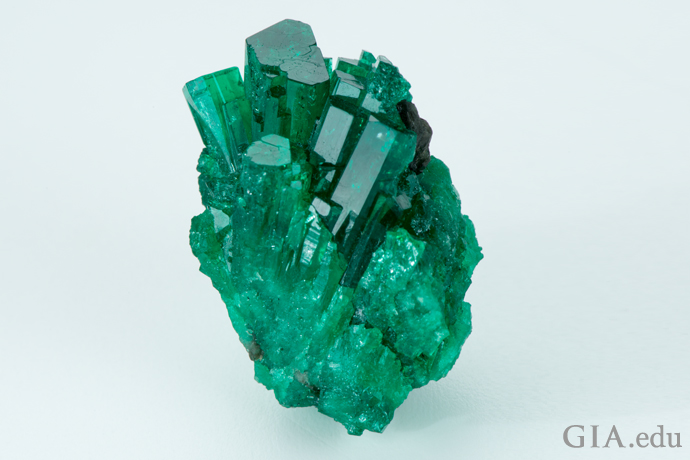
This 38 carat cluster of emerald crystals originated from Colombia’s Muzo Mine. Photo: Robert Weldon/GIA. Courtesy: Ismael Daoud
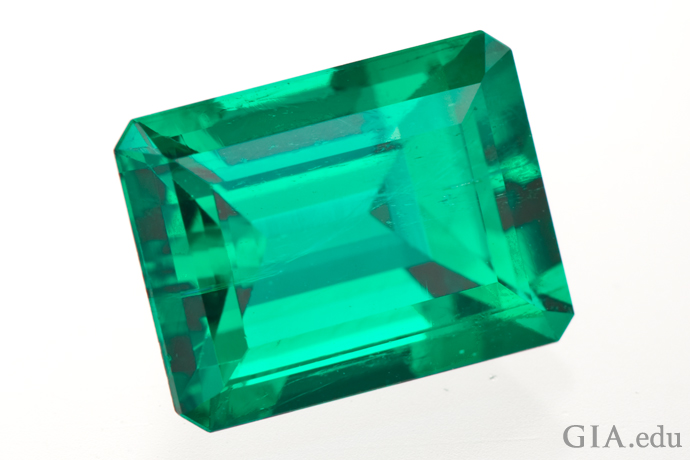
Chivor, Colombia is the source of this 4.50 ct emerald. Photo: Robert Weldon/GIA
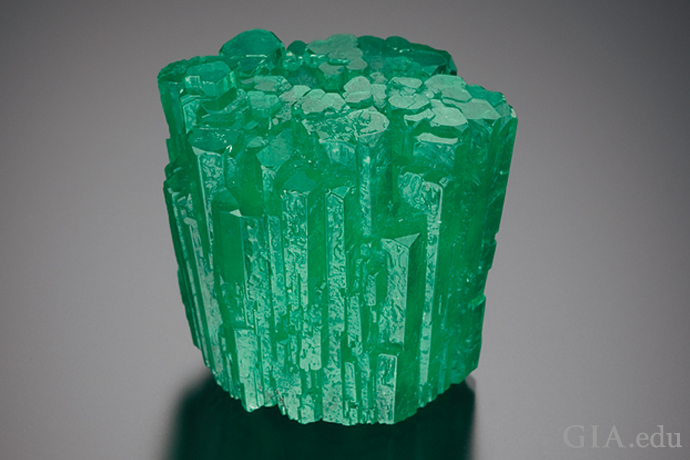
This 88.4 gram emerald crystal cluster is from Coscuez, Colombia. Photo: Robert Weldon/GIA. Courtesy: Gene Meieran
Emeralds are also found in the state of Minas Gerais, Brazil. One of the most productive sites for the May birthstone is the sophisticated Belmont Mine. Capoeirana is another important locality, a rugged region worked largely by independent miners and small-scale operations.
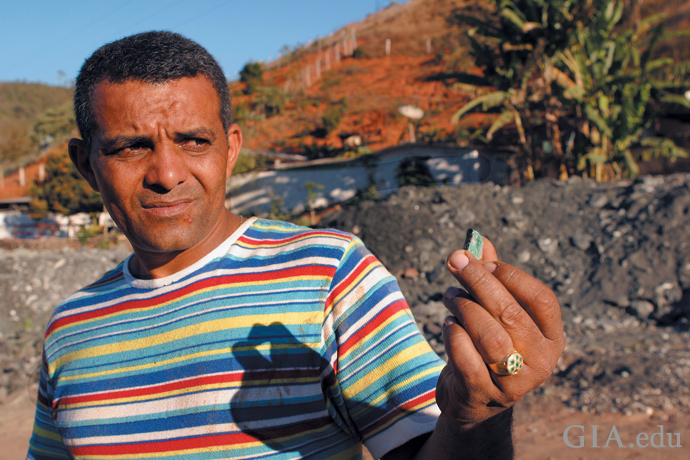
An independent miner at the Capoeirana mining area holds a rough emerald. Photo: Eric Welch/GIA
The May birthstone can also be found in Africa. Zambia is a major source, and mines in the Ndola Rural Restricted Area are known for producing emeralds that are bluish green and darker in tone. Pakistan and Afghanistan are important producers as well.
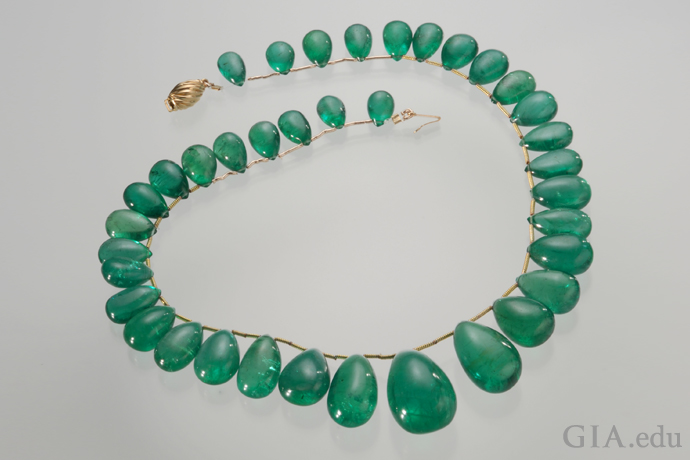
The 240 carats of emeralds in this drop necklace come from Zambia. Photo: Robert Weldon/GIA. Courtesy: Sanjay Chordia, BEACAB GEMS INC.
May Birthstone: Emerald Qualities to Look For
Color: The most important quality factor in the May birthstone is color. Emeralds that are bluish green to green, with strong to vivid saturation and medium to medium-dark tone, are the most coveted. Emeralds that are highly transparent are especially valuable.
Clarity: Emeralds typically contain inclusions that are visible to the unaided eye. Because of this, jewelry professionals and some consumers understand and accept the presence of inclusions in emeralds. Eye-clean emeralds are especially valuable because they’re so rare.
Emerald inclusions are often described as looking mossy or garden-like. They’re sometimes called jardin, which is French for “garden.”
In colored stones, transparency and clarity are closely linked. This is especially true for emeralds. Jewelry professionals generally accept some eye-visible inclusions in higher-quality emeralds. But when the quantity or nature of the inclusions has a negative effect on transparency and clarity, they also dramatically reduce value.
Cut: Emerald crystals are difficult to cut. Almost all rough emeralds have significant fractures (sometimes called fissures) and a gem cutter must work to minimize the effect of those fractures on the appearance of the finished stone.
These inherent fissures make emeralds more brittle than other gems. Consequently, they are vulnerable to damage during cutting, polishing and setting–or even from careless daily wear.
The famous rectangular “emerald cut,” with its beveled corners and two, three or four concentric rows of facets, maximizes the shape and weight of the original emerald crystal. It also helps protect against damage because the vulnerable corners are faceted and provide a comparatively safe place for prongs.
Carat Weight: Fashioned emeralds come in a wide range of sizes. There are emeralds in museums and private collections that weigh hundreds of carats. At the other extreme are tiny emeralds that weigh fractions of a carat.

Take extra caution when caring and cleaning for emerald jewelry like this 3.69 ct emerald ring flanked with six diamond side stones. Photo: Robert Weldon/GIA. Courtesy: Ismael Daoud
May Birthstone: Emerald Care & Cleaning
Emerald is a 7.5 to 8 on the Mohs scale of hardness, so it is more susceptible to scratching than a diamond, which ranks 10 on the scale. The May birthstone is often treated to improve its color and clarity. Common treatment methods include:
- Dyeing: Paler porous or fractured emeralds are dyed green to enhance their color.
- Fracture Filling: Oils, waxes and artificial resins are sometimes used to fill surface-reaching fractures in emeralds. The goal is to reduce the visibility of the fractures and improve the apparent clarity. The volume of filler material present can range from insignificant to major; these substances have varying degrees of stability.
Emerald requires some special care; avoid exposure to heat, changes in air pressure (such as in an airline cabin) and harsh chemicals. Never put an emerald in an ultrasonic cleaner. Filled emeralds can also be damaged by exposure to hot water used for washing dishes.
The May birthstone is perfectly suited to the celebration of life blooming everywhere. Now you can treat yourself – or a loved one – to an emerald that captures the exuberance of the season. Learn more about how to pick a beautiful emerald with our Emerald Buying Guide.
